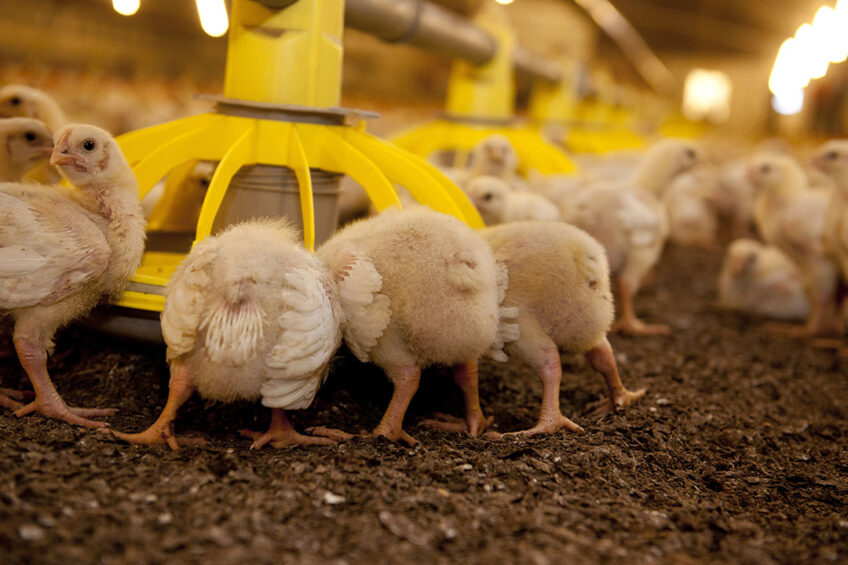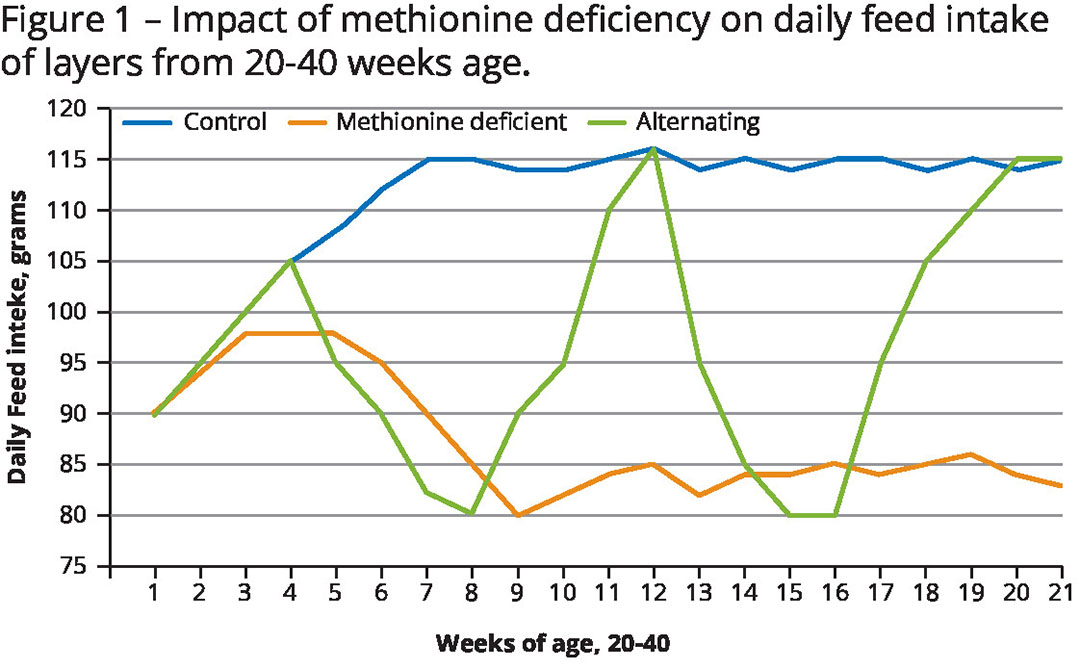Meeting the energy needs of poultry to perform optimally

All animals eat with reasonably good precision to balance their nutrient intake with requirement. Short term, there can be some variation in feed intake related to local situations, but long-term, the mechanisms of feed intake regulation are quite precise. Matching nutrient needs with intake is an obvious inherent evolutionary necessity.
A bird’s daily consumption of feed ultimately governs its health, growth, carcass composition and potential for egg production. Diets are usually formulated with an expectation of a specific intake of feed or, in special circumstances, we may dictate feed intake through controlled feeding systems. If birds eat less than our standards or goals, genetic potential is rarely achieved. An understanding of the mechanisms that control feed intake is therefore essential in designing nutritional programmes and how they are potentially impacted by our various farm production systems.
Chickens are omnivorous, which means that they will eat just about anything. Seeds and plant material often make up the bulk of their natural diet. However, chickens also readily eat insects, and small amphibians. Wild chickens also eat carrion, while instances of cannibalism can sometimes be precipitated by deficiencies of certain nutrients.
A willingness to accept a wide range of feedstuffs is an evolutionary adaptation used to overcome seasonal fluctuations in the supply of individual ingredients. However, being an omnivore does not mean that the chicken eats indiscriminately. Anyone who has spent time observing birds eat, realise just how selective they are in either picking out certain feed particles and/or subsequently swallowing (or not) of what has been selected. The selection of feed by the bird is influenced by many factors such as the sight, taste, and texture of feed, as well as its nutrient content.
The ability of the chicken to balance its own diet was eloquently researched by Dove (1935) who observed a remarkably consistent level of both daily feed and nutrient intake when birds were given free access to some 15 different conventional ingredients each offered buffet-style in separate containers.
Taste and texture of feed
Birds do not have a very well developed sense of taste. There are a few compounds that birds find distasteful, such as tannins in sorghum, although there is little evidence that chickens will voluntarily increase their feed intake in response to any flavouring agent. We have shown that birds have an eversion to both mushroom-type and cinnamon flavours. To date, no one has investigated potential of such flavours as a means of controlling feed intake.
On the other hand, feed texture is a major factor influencing feed particle choice by chickens. The preferred particle size increases as the bird grows, and we use this fact in changing from crumbs through to medium and then large pellets with broilers. Chicks are reluctant to eat very large particles, while older birds are reluctant to eat fine particles. As a generalisation, all ages of bird first eat the largest particles presented to them, often with small particles accumulating in the feed trough. We can advantageously use this inherent preference to either stimulate or suppress feed intake to some degree.
Birds always react positively to a novel feed texture, especially if this comprises just part of the diet, and this situation can be used to our advantage. For example, there is little doubt that the consumption of shell or large particle limestone by layers in part relates to a novel texture, especially in mash diets. Birds instantaneously react to top-dressing a diet with shell material, while no such reaction occurs with fine particle limestone. Likewise, under heat stress situations, top-dressing the feed with some molasses or even water can temporarily stimulate feed intake again due to change in feed texture.
Regulatory mechanisms
While feed texture and particle size greatly influence the initial selection of feed, there are complex biochemical process which regulate the fact that a layer usually eats about 110g of feed each day, or that a 40-day-old broiler consumes around 250g daily. Gut fill has some effect on short-term feed intake of chickens. Anyone who has palpated the crop on a 15-week-old broiler breeder pullet 2 hours after feeding may think that filling of the crop has a satiety effect on the bird. However, there is little evidence that crop-fill has a meaningful effect on intake because there are virtually no nerve endings in the crop which would be necessary to initiate a control feedback mechanism. The effect of crop-fill on feed intake is therefore very minor.

As feed is eaten, the process of digestion starts almost immediately and the complex components of the diet are broken down into their simple chemical constituents. These basic constituents are sugars, amino acids, and fatty acids. As these simple nutrients circulate in the blood, they influence special receptors in the brain, which tell the bird about its nutritional status.
For example, as feed is digested and glucose levels in the blood increase, a signal from the brain tells the bird to start limiting its feed intake. There are comparable mechanisms for amino acids, and perhaps even fatty acids. The situation with amino acids is especially interesting. Amino acids must be supplied in the correct ratio to each other, which we term a balanced protein. If this balance is not correct, it means that the amino acids cannot be used for growth or egg production. In this situation the brain senses the imbalance, and as a safety mechanism, feed intake is reduced. Layers, for example, will dramatically reduce their feed intake if the diet is deficient in methionine, because they know that they cannot manufacture eggs from such imbalanced protein.
The impact of amino acid deficiency in birds is eloquently shown when imbalanced mixtures are infused into either the carotid artery or the jugular vein. When infused into the carotid the mixture goes immediately to the brain regulatory sensors, and feed intake is reduced. When infused into the jugular, there is little impact on feed intake, since the liver has the chance to intervene and rebalance the amino acids before they eventually reach the brain sensors.
Maintaining a certain level of fat in the body likely has an influence on long-term (week-to-week) feed intake. Chickens also have specific appetites for individual nutrients. The best example occurs with calcium in layers. Once a bird starts to lay, it has an increased appetite for calcium, and given a choice feeding situation the layer can balance its diet to obtain around 4g calcium each day. For example, if the diet is slightly deficient in calcium, then she will increase her feed intake accordingly. This innate ability to sense nutrient balance of the diet is merely a protection system for the long-term well-being of the bird.
The overall gatekeeper of these regulatory systems are likely 2 hormones that essentially control/reduce feed intake. Leptin produced by the brain and Grehlin produced mainly in the proventriculus seem to be integral messengers in controlling/reducing feed intake. Evolving research suggests these hormones may also play a role in both reproduction and immunity.
Diet energy level
Under most practical feeding situations, the energy level of the diet is the major factor influencing feed intake. Within the regulatory mechanisms described in the previous section is an inherent system that very precisely controls the bird’s ‘daily’ energy intake. As energy concentration of the diet increases, a bird eats less feed, while a reduction in diet energy level prompts an increase in intake. This mechanism applies to all types and ages of chicken and is very precise and accurate.
In layers, the precise change in intake in response to change in diet energy concentration is achieved within just 1-2 days. The choice of diet energy level is therefore an economic decision and is the reason for varying energy concentrations used worldwide. Obviously as feed intake changes in response to diet energy concentration, the level of all other dietary nutrients is usually adjusted accordingly.
It has been suggested that the modern broiler chicken does not eat to its energy needs; rather, its intake is a factor of gut capacity related to its voracious appetite. Although the broiler can achieve intakes of dry matter that approach 10% of its body weight, which far exceeds the feeding rate for any other farm animal, it seems as though energy intake is still influential.
Diluting the diet of broilers by 50% causes the broilers to exactly double their intake, and so energy intake remains constant. At dilutions between the extremes, the broiler adjusts its feed intake perfectly and so energy intake remains constant regardless of the diet used. The confounding factor here is ability/time required by the bird to eat such diluted feed. On-farm, its not usually possible for broilers to spend twice as long eating diluted feed, and so there are practical limits to reducing diet energy. Consequently, the choice of diet energy level is not too critical from the birds perspective, and ultimately the choice is based upon economics and on-farm management systems.
Daily energy requirements
Since chickens eat quite accurately according to their energy needs, factors that influence energy needs have an immediate effect on daily feed intake. For example, when a layer pauses in egg production for a day, her feed intake declines by about 30g.
The major variable influencing energy requirements is environmental temperature. After brooding, an ideal temperature is 26°C. At temperatures below this, birds need more energy to maintain their body temperature, while in warmer weather, feed intake correspondingly declines. As an approximation, birds will adjust their intake by +/-1% for each -/+1°C change in temperature. For a laying hen this equates to about a 1g change in feed intake for each 1°C change in temperature and is the reason why we attempt to maintain layer facilities as warm as possible. Degree of feathering can greatly influence these calculations, especially in cooler climates. At 15°C vs 26°C, for example, a poorly feathered layer will eat almost 10g more feed daily compared to a well-feathered bird.
Long-term well-being
The chicken will eat a vast range of potential feedstuffs, although selection is very discriminate and is based on their long-term wellbeing. There are basic physiological mechanisms that control both short and long-term feed intake of chickens. Energy level of the diet is usually the single most important on-farm factor influencing feed intake. Birds will eat more of a low-energy diet and vice versa.
All chickens eat to their energy requirements with a fair degree of precision and so all factors that affect energy needs directly influence feed intake. Environmental temperature and stocking density are probably the 2 major on-farm variables that influence energy needs and hence feed intake.
Join 31,000+ subscribers
Subscribe to our newsletter to stay updated about all the need-to-know content in the poultry sector, three times a week. Beheer
Beheer











 WP Admin
WP Admin  Bewerk bericht
Bewerk bericht